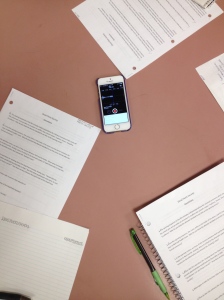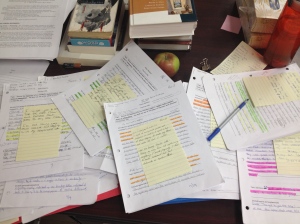What is Tiered Instruction?
- Teachers MUST know their curriculum in order uncover curricular outcomes
- Students always work in groups
- Teachers scaffold in order to provide support
- High-level, complex thinking can be built into every tier of instruction
- Leveled resource materials should be used.
My experience tiering in a High School English class:
I was teaching an 11th grade English class Macbeth. The lesson looked like this:
Macbeth
Essential Questions for the class:
Thematic: To what extent can a true hero be susceptible to temptation?
Literary: What literary devices does Shakespeare use in characterizing Macbeth and are they effective?
Equivocation/Antithesis and how they can be considered theme. Review of Tragic Hero. Review of Motif. Review Atmosphere. Tracing blood motif in Act I scene ii. Predict thematic significance of “blood”.
Tier 1: Define and identify antithesis, Motif, Atmosphere in Act I scenes i and ii in Macbeth.
Tier 2: What evidence about Macbeth’s character is given through the use of antithesis, Motif and Atmosphere in Act 1 scenes i and ii?
Tier 3: Are antithesis, motif and atmosphere effective literary devices for indirectly characterizing Macbeth?
Study of Macbeth Act 1 scenes i and ii.
- Read aloud Act 1 scene 1 of Macbeth. Assign parts. I’ll play witch 1 (use witchy voice).
- Define “Antithesis
An antithesis is used when the writer employs two sentences of contrasting meanings in close proximity to one another. Whether they are words or phrases of the same sentence, an antithesis is used to create a stark contrast using two divergent elements that come together to create one uniform whole. An antithesis plays on the complementary property of opposites to create one vivid picture. The purpose of using an antithesis in literature is to create a balance between opposite qualities and lend a greater insight into the subject.
- Explain tiring choices to students.
- Students get into tiered groups of 4-5
- Students work on answering questions. Students are to record their discussion and email to me.
- Once students have completed “tiered” choice they are to answer the thematic essential question.
- If this witches uses antithesis, and are perceived as being equivocator’s, what can we predict is their role in the play especially with regards to our tragic hero.
- Review definition of “motif” (repeated symbol that holds thematic significance)
- Small groups. Assign parts. Students read scene ii in small groups. As they readmake note of how many times “blood” is mentioned and under what context.
- What mood is created with this repetition? How is Macbeth referred to in relation to all the “blood”? (Students answer this in their groups).
- Share responses with entire class.
- Ask “What is the definition of Tragic Hero?
- Does the indirect characterization of Macbeth in this scene (by the bloody soldier and by Duncan) follow the definition of “tragic hero”?
- We’ve got witches (who mention Macbeth) we’ve got a dying soldier on a bloody battle field mentioning Macbeth. What kind of guy does he seem to be from all this evidence we’ve gleaned? Why do you suppose the witches want to “meet” with him upon the heath?
Assessment: Student responses (oral) Monitor and assess small group discussions.
Students answer questions to hand in (formative) recording.
- Does Macbeth seem heroic thus far? Does he seem to be the kind of hero that is easily “tempted”
- How do antithesis, equivocation and motif contribute to the atmosphere of the play thus far?
Specific outcomes:
- Discover possibilities (1.1.1)
- construct meaning from text (2.1.1,2.1.2,2.1.3,)
- Understand and appreciate textual forms, elements and techniques (2.2.2)5.2 work within a group (5.2.1,)
My reflection on the lesson:
Students automatically thought they needed to be in the first tier. It wasn’t because they thought it was easier, it seemed that they were insecure in their own skill level. About half the class chose tier 1 first. I sat with this large group and after 5 minutes most of them (all but 3/15) said “we’ve got this” and moved off into their groups and worked on tier 2 and 3.
Students finished recording their responses quicker than I thought. I had planned to have the “essential question” discussion as a class but I ended up assigning it as part of the tiered groups. Most groups naturally moved from tier 2 to 3 on their own without prompting from me. “we might as well move on to tier 2”.
Tomorrow’s class with be “tying up” discussion. I may share some of the group recordings!
If I had to do it over I would consider a tier 1 as a “check in”. Most students just needed validation of their understanding of motif etc.
Students liked recording discussions! I get them to do this quite regularly now. It seems to focus their “talk”, keep them on task and inspire them to organize their responses in a more academic tone.
I was encouraged that they took on teir 3 on their own initiative!
A good reference on tiering:
Armstrong, Sarah & Haskins, Haskins, Stephanie. (2010) A Practical Guide to Tiering Instruction in the differentiated classroom. New York: NY. Scholastic
Good websites on tiering:
http://daretodifferentiate.wikispaces.com/Tiering?responseToken=00d6267518d917e85a4c163dcf93cf185
https://challengebychoice.wordpress.com/tiered-instruction-and-assessment/
for math!: http://sjc-differentiation.wikispaces.com/Tiered+Math+Lesson?responseToken=0489d5b51590891f86937f908d7e772bc
http://www.livebinders.com/play/play/276513



